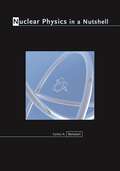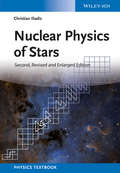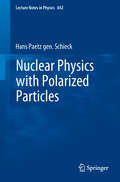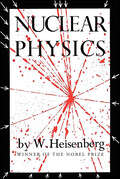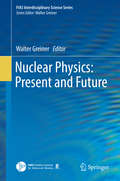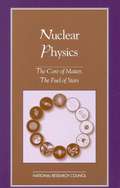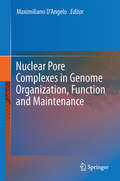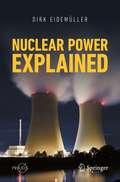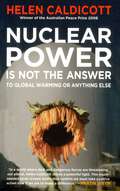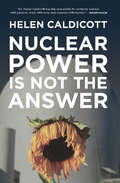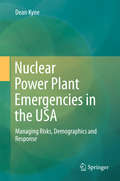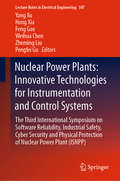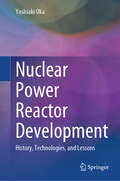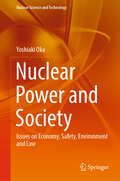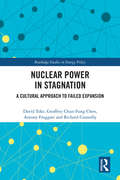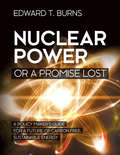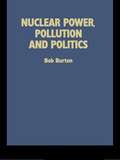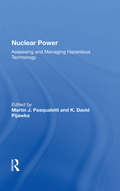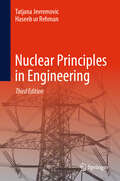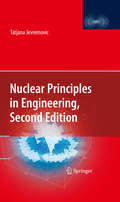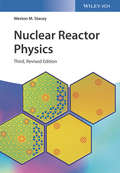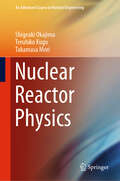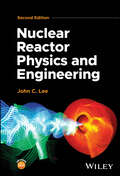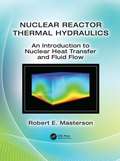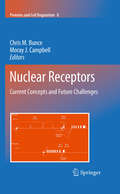- Table View
- List View
Nuclear Physics in a Nutshell (In a Nutshell #4)
by Carlos A. BertulaniNuclear Physics in a Nutshell provides a clear, concise, and up-to-date overview of the atomic nucleus and the theories that seek to explain it. Bringing together a systematic explanation of hadrons, nuclei, and stars for the first time in one volume, Carlos A. Bertulani provides the core material needed by graduate and advanced undergraduate students of physics to acquire a solid understanding of nuclear and particle science. Nuclear Physics in a Nutshell is the definitive new resource for anyone considering a career in this dynamic field. The book opens by setting nuclear physics in the context of elementary particle physics and then shows how simple models can provide an understanding of the properties of nuclei, both in their ground states and excited states, and also of the nature of nuclear reactions. It then describes: nuclear constituents and their characteristics; nuclear interactions; nuclear structure, including the liquid-drop model approach, and the nuclear shell model; and recent developments such as the nuclear mean-field and the nuclear physics of very light nuclei, nuclear reactions with unstable nuclear beams, and the role of nuclear physics in energy production and nucleosynthesis in stars. Throughout, discussions of theory are reinforced with examples that provide applications, thus aiding students in their reading and analysis of current literature. Each chapter closes with problems, and appendixes address supporting technical topics.
Nuclear Physics of Stars
by Christian IliadisMost elements are synthesized, or "cooked", by thermonuclear reactions in stars. The newly formed elements are released into the interstellar medium during a star's lifetime, and are subsequently incorporated into a new generation of stars, into the planets that form around the stars, and into the life forms that originate on the planets. Moreover, the energy we depend on for life originates from nuclear reactions that occur at the center of the Sun. Synthesis of the elements and nuclear energy production in stars are the topics of nuclear astrophysics, which is the subject of this book. It presents nuclear structure and reactions, thermonuclear reaction rates, experimental nuclear methods, and nucleosynthesis in detail. These topics are discussed in a coherent way, enabling the reader to grasp their interconnections intuitively. The book serves both as a textbook for advanced undergraduate and graduate students, with worked examples and end-of-chapter excercises, but also as a reference book for use by researchers working in the field of nuclear astrophysics.
Nuclear Physics with Polarized Particles
by Hans Paetz gen. SchieckThe measurement of spin-polarization observables in reactions of nuclei and particles is of great utility and advantage when the effects of single-spin sub-states are to be investigated. Indeed, the unpolarized differential cross-section encompasses the averaging over the spin states of the particles, and thus loses details of the interaction process. This introductory text combines, in a single volume, course-based lecture notes on spin physics and on polarized-ion sources with the aim of providing a concise yet self-contained starting point for newcomers to the field, as well as for lecturers in search of suitable material for their courses and seminars. A significant part of the book is devoted to introducing the formal theory--a description of polarization and of nuclear reactions with polarized particles. The remainder of the text describes the physical basis of methods and devices necessary to perform experiments with polarized particles and to measure polarization and polarization effects in nuclear reactions. The book concludes with a brief review of modern applications in medicine and fusion energy research. For reasons of conciseness and of the pedagogical aims of this volume, examples are mainly taken from low-energy installations such as tandem Van de Graaff laboratories, although the emphasis of present research is shifting to medium- and high-energy nuclear physics. Consequently, this volume is restricted to describing non-relativistic processes and focuses on the energy range from astrophysical energies (a few keV) to tens of MeV. It is further restricted to polarimetry of hadronic particles.
Nuclear Physics: Out Of My Later Years, Scientific Autobiography, And Nuclear Physics
by W. HeisenbergThe Nobel Prize–winning physicist offers a fascinating popular introduction to nuclear physics from early atomic theory to its transformative applications. Theoretical physicist Werner Heisenberg is famous for developing the uncertainty principle, which bears his name, and for his pioneering work in quantum mechanics. A central figure in the development of the atomic bomb and a close colleague of Albert Einstein, Heisenberg wrote Nuclear Physics &“for readers who, while interested in natural sciences, have no previous training in theoretical physics.&” Compiled from a series of his lectures on the subject, Heisenberg begins with a short history of atomic physics before delving into the nature of nuclear forces and reactions, the tools of nuclear physics, and its world-changing technical and practical applications. Nuclear Physics is an ideal book for general readers interested in learning about some of the most significant scientific breakthroughs of the twentieth century.
Nuclear Physics: Present and Future
by Walter GreinerState-of-the-art survey by leading experts in the field. Major foci are superheavy nuclei and neutron-rich exotic nuclei. In addition new developments in nuclear fission and nuclear cluster decay are shown. Finally developments in relativistic heavy ion collisions and the physics of supercritical fields are detailed.
Nuclear Physics: The Core of Matter, The Fuel of Stars
by National Research CouncilDramatic progress has been made in all branches of physics since the National Research Council's 1986 decadal survey of the field. The Physics in a New Era series explores these advances and looks ahead to future goals. The series includes assessments of the major subfields and reports on several smaller subfields, and preparation has begun on an overview volume on the unity of physics, its relationships to other fields, and its contributions to national needs.Nuclear Physics is the latest volume of the series. The book describes current activity in understanding nuclear structure and symmetries, the behavior of matter at extreme densities, the role of nuclear physics in astrophysics and cosmology, and the instrumentation and facilities used by the field. It makes recommendations on the resources needed for experimental and theoretical advances in the coming decade.
Nuclear Pore Complexes in Genome Organization, Function and Maintenance
by Maximiliano D’AngeloThe three-dimensional organization of the DNA inside the eukaryotic cell nucleus has emerged a critical regulator of genome integrity and function. Increasing evidence indicates that nuclear pore complexes (NPCs), the large protein channels that connect the nucleus to the cytoplasm, play a critical role in the establishment and maintenance of chromatin organization and in the regulation of gene activity. These findings, which oppose the traditional view of NPCs as channels with only one: the facilitation of nucleocytoplasmic molecule exchange, have completely transformed our understanding of these structures. This book describes our current knowledge of the role of NPCs in genome organization and gene expression regulation. It starts by providing an overview of the different compartments and structures of the nucleus and how they contribute to organizing the genome, then moves to examine the direct roles of NPCs and their components in gene expression regulation in different organisms, and ends by describing the function of nuclear pores in the infection and genome integration of HIV, in DNA repair and telomere maintenance, and in the regulation of chromosome segregation and mitosis. This book provides an intellectual backdrop for anyone interested in understanding how the gatekeepers of the nucleus contribute to safeguarding the integrity and function of the eukaryotic genome.
Nuclear Power Explained (Springer Praxis Books)
by Dirk EidemüllerFrom World War II to the present day, nuclear power has remained a controversial topic in the public eye. In the wake of ongoing debates about energy and the environment, policymakers and laypeople alike are once more asking the questions posed by countless others over the decades: What actually happens in a nuclear power plant? Can we truly trust nuclear energy to be safe and reliable? Where does all that radiation and waste go? This book explains everything you would want to know about nuclear power in a compelling and accessible way. Split into three parts, it walks readers through the basics of nuclear physics and radioactivity; the history of nuclear power usage, including the most important events and disasters; the science and engineering behind nuclear power plants; the politics and policies of various nations; and finally, the long-term societal impact of such technology, from uranium mining and proliferation to final disposal. Featured along the way are dozens of behind-the-scenes, full-color images of nuclear facilities. Written in a nontechnical style with minimal equations, this book will appeal to lay readers, policymakers and professionals looking to acquire a well-rounded view about this complex subject.
Nuclear Power Is Not The Answer To Global Warming Or Anything Else
by Helen CaldicottIn this revealing examination of the costs and consequences of nuclear energy, world-renowned antinuclear spokesperson Helen Caldicott uncovers the facts that belie the nuclear industry propaganda: nuclear power contributes to global warming; the true cost of nuclear power is prohibitive, with taxpayers picking up most of the tab; there's simply not enough uranium in the world to sustain nuclear power over the long term; and the potential for a catastrophic accident or a terrorist attack far outweighs any benefits. Trained as a physician and thoroughly versed in the science of nuclear energy, the bestselling author of Nuclear Madness and Missile Envy here turns her attention from nuclear bombs to nuclear lightbulbs. As she makes meticulously clear in this essential book, the world cannot withstand either.
Nuclear Power Is Not the Answer
by Helen CaldicottThe renowned antinuclear activist delivers a &“frighteningly convincing argument&” against nuclear energy as a solution to climate change (Publishers Weekly). In a world torn apart by wars over oil, politicians have stepped up their search for alternative energy sources—and their leading choice is nuclear energy. But nuclear energy&’s popularity as a green alternative is based on misinformation. People claim that nuclear-powered electricity does not cause global warming or pollution, that it is inexpensive, and that it is safe. These claims, as Helen Caldicott demonstrates, are untrue. In Nuclear Power Is Not the Answer, Caldicott digs beneath the nuclear industry&’s propaganda to examine the actual costs and environmental consequences of nuclear energy. In fact, nuclear power does contribute to global warming; the cost is prohibitive, with taxpayers picking up most of the tab; there&’s not enough uranium in the world to sustain it over the long term; and the potential for a catastrophic accident or a terrorist attack far outweighs any benefits. In concluding chapters, Caldicott details alternative sustainable energy sources that are the key to a clean, green future.
Nuclear Power Plant Emergencies in the USA: Managing Risks, Demographics and Response
by Dean KyneManaging nuclear power emergencies is significantly different from managing other types of emergencies, including fire, flood, and other disasters because nuclear disaster management requires special technical skills and a rigid protocol which outlines detailed steps and procedure before an evacuation announcement could be made. It was evident that the impacts from a nuclear power core-meltdown accident were immerse, irreversible, and inevitable, as evident by evaluating the three historic core-meltdown accidents, namely Three Mile Island in 1997, Chernobyl in 1986, and Fukushima Daiichi in 2011. The three options for minimizing the risks associated with NPPs are suggesting elimination of all NPPs in operation in the United States, transforming inevitable risks to evitable risks, and transforming the current radiological plan into an effective emergency management plan. Being the latter option is the only viable one, this book provides a comprehensive understanding on effectively managing nuclear power emergencies in the U.S. The book presents detailed analysis on effectively managing nuclear power emergencies. In an attempt to illustrate minimizing the risks, factual answers to the key questions surrounding managing nuclear disasters are outlined. What are the risks associated with the nuclear power plants (NPP)? What are the problems associated with managing nuclear power core-meltdown accidents in the three historic accidents? Where are the geographical locations of the 99 commercial reactors in the U.S? Who are those exposed to potential risks associated with the NPPs? How could a projection of radioactive plume dispersion pathway be carried out using a spatial computer code, such as the Radiological Assessment Systems for Consequence Analysis (RASCAL) in case of a core-meltdown accident? Where would the radioactive plume go given weather conditions? Who are more likely to be exposed to the high level radiation dose during the core-meltdown accident? What are the issues with the current radiological emergency plan?
Nuclear Power Plants: The Third International Symposium on Software Reliability, Industrial Safety, Cyber Security and Physical Protection of Nuclear Power Plant (ISNPP) (Lecture Notes in Electrical Engineering #507)
by Yang Xu Feng Gao Weihua Chen Zheming Liu Pengfei Gu Hong XiaThis book is a compilation of selected papers from the 3rd International Symposium on Software Reliability, Industrial Safety, Cyber Security and Physical Protection of Nuclear Power Plants, held in Harbin, China on 15th–17th August 2018. The symposium discussed the status quo, technical advances and development direction of digital instrument control technology, software reliability, information security and physical protection in the process of nuclear power development. Offering technical insights and know from leading experts, this book is a valuable resource for both practitioners and academics working in the field of nuclear instrumentation, control systems and other safety-critical systems, as well as nuclear power plant managers, public officials, and regulatory authorities.
Nuclear Power Reactor Development: History, Technologies, and Lessons
by Yoshiaki OkaThis book offers a comprehensive exploration of the history and development of power reactors worldwide, from their inception to the present day. It provides an in-depth analysis of light water reactors and their global technology, while also delving into the evolution of gas-cooled, heavy water, liquid metal-cooled, aerospace, and nuclear fusion reactors. By examining past advancements, this book equips readers with the insights necessary to apply lessons learned to future reactor development and utilization. Key concepts include the dominance of light water reactors in the global market, the progression of nuclear fuel cycle technologies, and the economic and political aspects of plutonium utilization. The book also addresses critical questions such as the potential depletion of uranium resources and the characteristics of Generation III and IV reactors. With contributions from government agencies and international organizations, this work is a must-read for those seeking a thorough understanding of nuclear reactor history and future challenges. Intended for graduate students, university faculty, researchers, industry professionals, and anyone with a keen interest in nuclear power, this book serves as a vital resource for understanding the complexities of nuclear reactor development and the broader implications for society. The translation was done with the help of artificial intelligence. A subsequent human revision was done primarily in terms of content.
Nuclear Power and Society: Issues on Economy, Safety, Environment and Law (Nuclear Science and Technology)
by Yoshiaki OkaThis book offers a comprehensive description of the issues at the boundary between the use of nuclear power and society. Highlighting critical social topics such as economic liberalization, risk communication, radioactive waste, accountability, and non-proliferation, it provides an in-depth exploration of the multifaceted relationship between nuclear technology and societal impacts. The book covers a wide range of topics including the intersection of nuclear technology with economics, engineering, environmental studies, and law. Readers delve into the lessons learned from the TEPCO Fukushima accident, understand the complexities of risk communication, and explore the legal frameworks governing nuclear energy use. The highlighted issues at the interface between nuclear power utilization and society are meticulously organized, referring to historical information and insights from European and American government agencies and international organizations. This book is an essential read for graduate students, researchers, professors, engineers, government officials, and anyone interested in the social issues surrounding nuclear utilization. Written by an experienced professional who served as chairman of the Japan Atomic Energy Commission, it combines expert analysis with an engaging style to make complex topics accessible to a broad audience. The translation was done with the help of artificial intelligence. A subsequent human revision was done primarily in terms of content.
Nuclear Power in Stagnation: A Cultural Approach to Failed Expansion (Routledge Studies in Energy Policy)
by David Toke Richard Connolly Geoffrey Chun-Fung Chen Antony FroggattThis book studies the extent to which nuclear safety issues have contributed towards the stagnation of nuclear power development around the world, and accounts for differences in safety regulations in different countries. In order to understand why nuclear development has not met widespread expectations, this book focusses on six key countries with active nuclear power programmes: the USA, China, France, South Korea, the UK, and Russia. The authors integrate cultural theory and theory of regulation, and examine the links between pressures of cultural bias on regulatory outcomes and political pressures which have led to increased safety requirements and subsequent economic costs. They discover that although nuclear safety is an important upward driver of costs in the nuclear power industry, this is influenced by the inherent need to control potentially dangerous reactions rather than stricter nuclear safety standards. The findings reveal that differences in the strictness of nuclear safety regulations between different countries can be understood by understanding differences in cultural contexts and the changes in this over time. This book will be of great interest to students, scholars, and policymakers working on energy policy and regulation, environmental politics and policy, and environment and sustainability more generally.
Nuclear Power or a Promise Lost: A Policy Maker's Guide for a Future of Carbon Free, Sustainable Energy
by Edward T. BurnsThis book captures the status of current electrical energy markets including the principal forces affecting decisions on selecting an energy source. It represents a seminal work that lays out the electrical energy decision tree for selecting an energy sou
Nuclear Power, Pollution and Politics
by Bob BurtonPlaces the environmental issues related to the production of nuclear power in their political context. It evaluates the extent of nuclear pollution, in comparison with other forms of power, and looks at the future of energy.
Nuclear Power: Assessing And Managing Hazardous Technology
by Martin J PasqualettiAddressing the major issues surrounding the use of nuclear power, twenty-nine social scientists with extensive involvement in the assessment and management of nuclear technology discuss critical areas of concern--problem recognition, risk estimation, and policy formation and implementation. The authors appraise fundamental policy issues and examine
Nuclear Principles in Engineering
by Tatjana Jevremovic Haseeb ur RehmanSeveral emerging application areas are driving a revival in nuclear engineering, including new nuclear reactor designs (advanced water-cooled reactors, small modular reactors, and microreactors) and their various applications beyond electricity production and a revolution in nuclear medicine, nuclear space exploration, hydrogen production, and homeland security. This fully updated introductory textbook provides students and practitioners with the fundamentals of nuclear principles in engineering for a thorough understanding of physical processes relating to neutron physics, nuclear structures, and radiation interactions. To comprehend physical phenomena, hands-on computational exercises supported by mathematical details and real-life examples are provided to communicate the nuclear principles concepts. A new chapter details the evolution of nuclear power plants, explaining the modern-day technologies based on design details linked to the basic principles of nuclear engineering. In addition, every chapter is supplied with the problems solutions and answers. Nuclear Principles in Engineering, Third Edition, is written for students, engineers, physicists, and scientists who need up-to-date information on basic nuclear concepts and calculation methods, and will serve as an invaluable resource for training programs in the nuclear sector.
Nuclear Principles in Engineering
by Tatjana JevremovicNuclear engineering plays an important role in various industrial, health care, and energy processes. Modern physics has generated its fundamental principles. A growing number of students and practicing engineers need updated material to access the technical language and content of nuclear principles. "Nuclear Principles in Engineering, Second Edition" is written for students, engineers, physicians and scientists who need up-to-date information in basic nuclear concepts and calculation methods using numerous examples and illustrative computer application areas. This new edition features a modern graphical interpretation of the phenomena described in the book fused with the results from research and new applications of nuclear engineering, including but not limited to nuclear engineering, power engineering, homeland security, health physics, radiation treatment and imaging, radiation shielding systems, aerospace and propulsion engineering, and power production propulsion.
Nuclear Reactor Physics
by Weston M. StaceyThis third, completely revised edition of the textbook retains the proven concept of complete and balanced coverage of the topic. The first part looks at basic reactor physics, including, but not limited to nuclear reactions, diffusion theory, reactor dynamics, fuel burnup and reactor safety. The second part then deals with such physically and mathematically more advanced topics as neutron transport theory, resonance absorption and neutron thermalization. For ease of reference, the detailed appendices contain nuclear data, useful mathematical formulas, an overview of special functions as well as an introduction to matrix algebra and Laplace transforms. With its focus on conveying the in-depth knowledge needed by advanced student and professional nuclear engineers, this text is ideal for use in numerous courses, including nuclear reactor physics, advanced nuclear reactor physics, neutron transport theory, nuclear reactor dynamics and stability, and nuclear reactor fuel cycle physics.
Nuclear Reactor Physics (An Advanced Course in Nuclear Engineering #5)
by Shigeaki Okajima Teruhiko Kugo Takamasa MoriThis book covers introductory subjects including fundamental principles of nuclear reactions with neutrons, fundamentals of nuclear fission chain reactions, basic concepts of criticality, and static characteristics based on diffusion approximation in neutron transport. The chapters address topics ranging from neutron moderation from fission to thermal energy ranges and heterogeneity effects in neutronics. Readers will find elementary and qualitative descriptions and also mathematical expressions including approximations, derivations and analytical solutions for an understanding of the basic principles of nuclear reactor physics. This book is part of a series entitled An Advanced Course in Nuclear Engineering and provides an accessible introduction to the core discipline of nuclear engineering: nuclear reactor physics. It will therefore appeal to engineers in nuclear engineering as well as to university students and others seeking to learn entry-level reactor physics.
Nuclear Reactor Physics and Engineering
by John C. LeeEssential guide to analyzing nuclear energy systems, with focus on reactor physics, fuel cycle, system dynamics, thermal-hydraulics, and economics. Nuclear Reactor Physics and Engineering highlights efforts in utilizing low enrichment uranium fuel as a substitute for carbon-based fuels in energy generation and provides an overview of important aspects of nuclear reactor physics utilizing the neutron diffusion equation for major reactor designs and MATLAB software for system analysis, with exercises illustrating key points and design parameters as supplementary material. This revised and updated Second Edition reflects key findings of the 2023 National Academy of Sciences (NAS) report and discusses physical and engineering characteristics of advanced nuclear reactors, especially in the form of small modular reactors that have the potential to provide enhanced safety and economics, as well as effective long-term management of used nuclear fuel in geological repositories. Key topics explored in the updated edition of Nuclear Reactor Physics and Engineering include: Impact of the use of high-assay low enrichment uranium (HALEU) fuel as a new efficient nuclear fuelAdvantages resulting from combined uses of light water reactor and sodium-cooled fast reactor with fuel reprocessingFundamental nuclear reactor physics, nuclear reactor system analysis, and lattice physics analysis for reactor cores Nuclear fuel cycle analysis, nuclear plant simulation and control, and management of used nuclear fuelEconomic analysis of nuclear electricity and thermal-hydraulic analysis of nuclear systems. With a wealth of all-new information detailing the state of the art in the field, Nuclear Reactor Physics and Engineering is an invaluable reference on the subject for undergraduate and graduate students in nuclear engineering, as well as practicing engineers involved with nuclear power plants.
Nuclear Reactor Thermal Hydraulics: An Introduction to Nuclear Heat Transfer and Fluid Flow
by Robert E. MastersonNuclear Thermal-Hydraulic Systems provides a comprehensive approach to nuclear reactor thermal-hydraulics, reflecting the latest technologies, reactor designs, and safety considerations. The text makes extensive use of color images, internet links, computer graphics, and other innovative techniques to explore nuclear power plant design and operation. Key fluid mechanics, heat transfer, and nuclear engineering concepts are carefully explained, and supported with worked examples, tables, and graphics. Intended for use in one or two semester courses, the text is suitable for both undergraduate and graduate students. A complete Solutions Manual is available for professors adopting the text.
Nuclear Receptors
by Moray J. Campbell Chris M. BunceIn 1890 a case of myxedema was treated in Lisbon by the implantation of a sheep thyroid gland with the immediate improvement in the patient's condition. A few years later, medications for the then ill-explained condition of the menopause included tablets made from cow ovaries. In the first quarter of the 20th century the identification of vitamin D, and its sunlight driven production in skin, paved the way to the elimination of rickets as a major medical problem. Twenty years or so later, Sir Vincent Wigglesworth established the endocrine basis of developmental moulting in insects, arguably the most commonly performed animal behaviour on Planet Earth. A paradigm that would unify these disparate observations arose between 1985 and 1987 beginning with the identification of the glucocorticoid receptor and the nuclear receptor super-family. What follows is a timely and positive manifestation of the capacity, productivity and value of international human scientific endeavour. Based on intrigue, lively competition and cooperation a global effort has rapidly fostered a school of biology with widespread ramifications for the understanding of metazoan animals, the human condition and the state of the planet. This book is the first this century to try and capture the spirit of this endeavour, to depict where the field is now and to identify some of the challenges and opportunities for the future.
